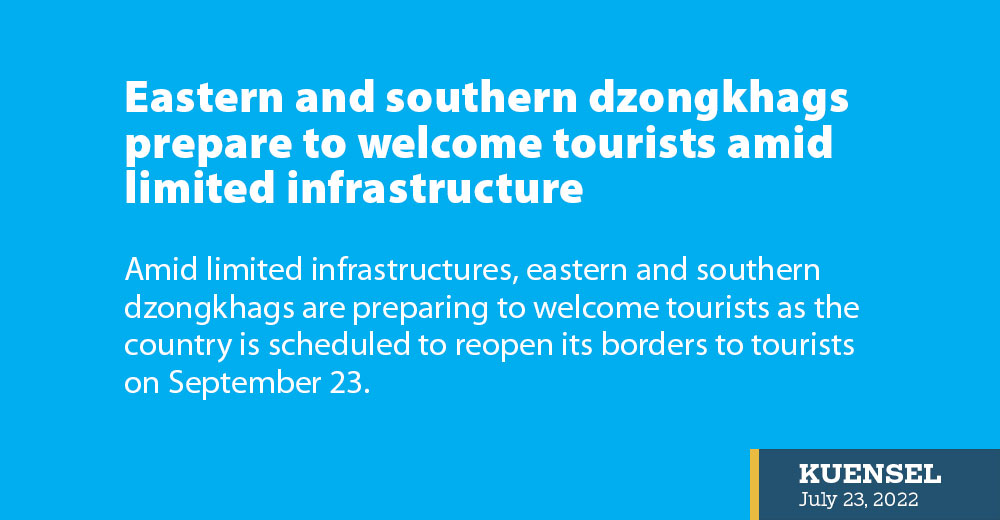MB Subba
Amid limited infrastructures, eastern and southern dzongkhags are preparing to welcome tourists as the country is scheduled to reopen its borders to tourists on September 23.
In addition to the Phuentsholing gate, the government will open Samdrupjongkhar, Gelephu and Samtse gates as new entry and exit points for tourists, according to Foreign Minister Dr Tandi Dorji, who is also the chairperson of the Tourism Council of Bhutan (TCB).
He said that tourists would be allowed to travel to any place after paying the SDF except for some places that are being identified. “We are preparing a list of places tourists will not have access to,” he said.
The TCB is marking areas within which tourists can enter without paying SDF. Currently, tourists who come to border towns return on the same day.
However, the foreign minister said that TCB was considering allowing tourists to stay overnight at the border towns without paying SDF. This, officials said, would boost businesses in the border towns.
The TCB chairperson said that the required infrastructures for facilitating the entry of tourists at the gate were already in place and other facilities, if required, would be put in place before the country reopens for tourism.
A hotelier in Samdrupjongkhar said that implementation of the SDF should be deferred for eastern dzongkhags. He reasoned that the benefits of tourism had not reached some of the dzongkhags.
However, the TCB chairperson said that the government would not defer the implementation of SDF. “The question of deferring the implementation of SDF would not arise as the tourism levy Bill is an Act passed by Parliament,” he said.
Dr Tandi Dorji said that even international tourists would be allowed to enter through the new entry points. Road conditions, he said, were “good” in most of the places and that the country was ready to welcome tourists.
Some tourist-based entrepreneurs are of the view that financial institutions should provide soft loans to develop for development of infrastructures in the dzongkhags that are backward in terms of tourism development.
They say that it is not possible for eastern dzongkhags to compete with other dzongkhags without help from the government and financial institutions. Some hotels across the are being renovated to welcome tourists.
Tourists coming from India through Samdrupjongkhar will have easy access to eastern dzongkhags.
Gangzur Minjey MP Kinga Penjor in an earlier interview said that he did not expect a huge number of tourists to visit eastern dzongkhags initially. The number of tourists, he said, was expected to increase gradually with the improvement in infrastructures.
However, a businessman in Samdriupjongkhar said that some of the eastern dzongkhags lacked adequate infrastructure to host high-end tourists. He said that while the east-west highway was under construction, the Yonphula domestic airport had not been able to operate regularly due to weather conditions.
MP Tek Bdr Rai from Shompangkha in Sarpang said that infrastructures like hotels had been built during the past few years in the dzongkhag. He said that allowing tourists to stay overnight in the border towns without paying SDF would benefit the businesses.
The opening of the Gelephu gate, he said, would benefit not only Sarpang but also the neighbouring dzongkhags, including Tsirang and Dagana. “Damphu town itself is an attractive tourist destination because of the flowers that make it beautiful,” he said.
The Gelephu gate is also expected to provide access to Zhemgang.
Dagana, officials say, is one of the central dzongkhags with tourism potential.
The chairperson of Dagana Tshogdu, Bal Bdr Rana, said that tourism infrastructures were being developed in the dzongkhag.
Some of the families, he said, had converted their houses into farmhouses in gewogs, including Tseza. S youth group was also working out tourist-based businesses like rafting and farmhouses, he added.
He said the Dagala track, which starts from Tseza near Daga Dzong to Genekha in Thimphu is also being revived as part of the tourism development programme. “Dagana also has religious and cultural sites,” adding that sections of the Sunkosh river could be developed as rafting sites.
It would be easier for tourists who come from India through Samtse to reach Haa, which is one of the popular tourist destinations in the country. In the past, regional tourists who travelled to Haa came through Phuentsholing.


